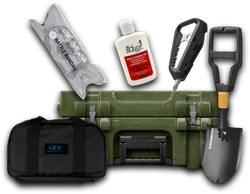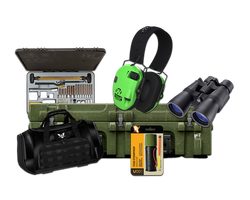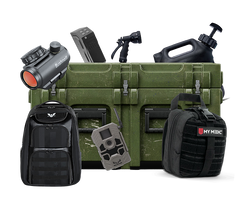光纤瞄准镜值得购买吗?
Table of Contents
- Introduction
- What Are Fiber Optic Sights?
- Advantages of Fiber Optic Sights
- Disadvantages of Fiber Optic Sights
- Comparing Fiber Optic Sights to Traditional Iron Sights
- Fiber Optic Sights in Different Firearms
- Hybrid Fiber Optic/Tritium Night Sights
- Conclusion
- FAQ
Introduction
Imagine standing at the shooting range under a blazing sun, trying to align your sights on a target but struggling to see the traditional iron sights. Frustrating, right? This scenario has led many shooters to explore alternatives that offer better visibility and quicker target acquisition. Fiber optic sights have emerged as a popular solution, promising enhanced performance in various lighting conditions. Yet, the question remains: Are fiber optic sights worth getting?
In this comprehensive blog post, we will delve into the intricacies of fiber optic sights, exploring their advantages and disadvantages, how they compare with traditional iron sights, and the specific contexts in which they excel. We’ll also examine their usage across different firearms, such as pistols, shotguns, and rifles, providing insights and recommendations to help you make an informed decision.
By the end of this post, you will have a thorough understanding of fiber optic sights, their functionality, and whether they fit your shooting needs. Whether you're a seasoned marksman or a novice looking to upgrade your gear, this guide will empower you to choose the right sights for your firearm.
What Are Fiber Optic Sights?
Fiber optic sights are a type of firearm sight that uses a fiber optic cable to gather ambient light and illuminate the sight. The fibers are typically encased in a protective housing and are available in various colors, such as red, green, and orange, to enhance visibility. These sights work by refracting light, allowing for a bright and easily visible aiming point, especially in daylight conditions.
How Do They Work?
The fiber optic material absorbs and transmits light, creating a glowing effect that makes the front sight more noticeable against a target. This technology enables shooters to acquire their sights faster, especially in environments with varying light conditions. The principle behind fiber optics is relatively simple: they do not reflect or bend light but instead harness natural light and direct it toward the user’s eye.
The Science of Visibility
Human vision is particularly attuned to certain wavelengths of light. Yellow and green fiber optics are often more visible than red due to their position within the visible color spectrum. This means that while red fiber optics can be effective, many shooters find that green or yellow options offer better contrast and visibility, especially in bright conditions.
Advantages of Fiber Optic Sights
Enhanced Visibility
One of the most significant advantages of fiber optic sights is their enhanced visibility. In bright sunlight or well-lit environments, fiber optics can appear extremely bright, allowing for quick target acquisition.
Faster Target Acquisition
The bright colors of fiber optic sights can help shooters align their sights more quickly. This is especially beneficial in dynamic shooting situations where speed is crucial, such as in competition shooting or self-defense scenarios.
Easy to Replace
Many fiber optic sights are designed for easy replacement. If the fiber optic itself becomes damaged, it can often be replaced without needing to change the entire sight assembly.
Lightweight and Compact
Fiber optic sights are generally lightweight and compact, making them an excellent choice for those looking to minimize the bulk of their firearm without sacrificing performance.
Disadvantages of Fiber Optic Sights
Limited Low-Light Performance
While fiber optic sights excel in bright conditions, they can struggle in low-light environments. They require ambient light to illuminate the fiber optic strands, which may lead to difficulty in dark settings. This limitation is a critical consideration for self-defense scenarios, where lighting conditions can be unpredictable.
Durability Concerns
The fiber optic rods can be fragile and may break upon impact or if subjected to rough handling. Although many manufacturers have made strides in enhancing the durability of these sights, they can still be more prone to damage compared to traditional all-steel sights.
Color Sensitivity
Not all shooters perceive colors the same way. Individuals with color blindness may find certain fiber optic colors challenging to see, which could hinder their effectiveness. This is an essential factor to consider when choosing the color of your fiber optic sights.
Comparing Fiber Optic Sights to Traditional Iron Sights
Visibility and Performance
When comparing fiber optic sights to traditional iron sights, visibility is one of the most notable differences. Fiber optics provide a bright, glowing point of aim, while iron sights can sometimes become difficult to see in bright conditions. This can lead to slower target acquisition and decreased accuracy.
Ease of Use
Fiber optic sights are often easier to use for beginners, as the bright colors help shooters quickly find their point of aim. On the other hand, traditional iron sights require more practice to master, as they involve aligning three points: the front sight, the rear sight, and the target.
Durability and Maintenance
Iron sights typically offer superior durability compared to fiber optic sights. Made from steel or aluminum, they can withstand harsher conditions and rough handling. Fiber optics, while increasingly robust due to advancements in production, still require careful handling to avoid damage.
Fiber Optic Sights in Different Firearms
Fiber Optic Sights for Pistols
Fiber optic sights are most commonly found on handguns, where quick target acquisition is essential. Many competitive shooters prefer fiber optic sights for their speed in aligning the sights. They can be especially beneficial in high-stress situations, like competitive shooting or self-defense.
Recommended Products for Pistols
Crate Club offers a range of tactical gear, including fiber optic sights that have been rigorously tested for performance. For those looking to enhance their pistol setup, consider the following options available through the Crate Club Shop.
Fiber Optic Sights for Shotguns
Shotguns are another area where fiber optic sights excel. Whether for hunting or home defense, fiber optics provide fast target acquisition, crucial for moving targets. The visibility helps shooters align their sights quickly, especially in dynamic shooting scenarios like skeet or trap shooting.
Fiber Optic Sights for Rifles
Rifles can also benefit from fiber optic technology. Many rimfire rifles and lever-action guns come equipped with fiber optic sights, enhancing visibility for small game hunting or target shooting. However, for longer-range shooting, shooters may still prefer traditional scopes for precision.
Hybrid Fiber Optic/Tritium Night Sights
To address the limitations of fiber optic sights in low-light conditions, hybrid sights that combine fiber optics with tritium have become popular. Tritium provides illumination in total darkness, while fiber optics enhance visibility in daylight. This combination offers the best of both worlds for tactical shooters who need reliable performance in varying conditions.
Conclusion
In summary, fiber optic sights offer significant advantages in visibility and target acquisition speed, making them a worthwhile consideration for many shooters. However, their limitations in low-light conditions and potential durability concerns should not be overlooked. Ultimately, the decision to switch to fiber optic sights depends on your shooting needs, preferences, and the types of environments in which you typically shoot.
For those interested in upgrading their gear, Crate Club offers an excellent selection of fiber optic sights and other tactical equipment through their subscription service. This ensures that you receive high-quality gear tailored to your specific needs every month.
FAQ
1. Are fiber optic sights effective in low-light conditions?
Fiber optic sights are less effective in low-light conditions because they rely on ambient light to be visible. In total darkness, they may not provide adequate visibility compared to tritium night sights.
2. Can fiber optic sights be used for self-defense?
Yes, fiber optic sights can be used for self-defense, but it is essential to pair them with a flashlight or weapon-mounted light for low-light situations. This combination allows for better target identification and sight visibility.
3. What colors are best for fiber optic sights?
Green and yellow fiber optic sights are often considered the most visible due to how the human eye perceives light. However, personal preference and specific shooting conditions should guide your choice.
4. How durable are fiber optic sights?
While many manufacturers have improved the durability of fiber optic sights, they can still be more fragile than traditional iron sights. It is crucial to handle them carefully and choose high-quality options.
5. Are fiber optic sights worth the investment?
For many shooters, fiber optic sights are worth the investment due to their enhanced visibility and quicker target acquisition. However, they may not be the best choice for everyone, especially those who primarily shoot in low-light conditions.
By carefully considering your shooting needs and preferences, you can determine whether fiber optic sights are the right choice for you. Remember, the right gear can significantly enhance your shooting experience and performance.
分享这篇文章



